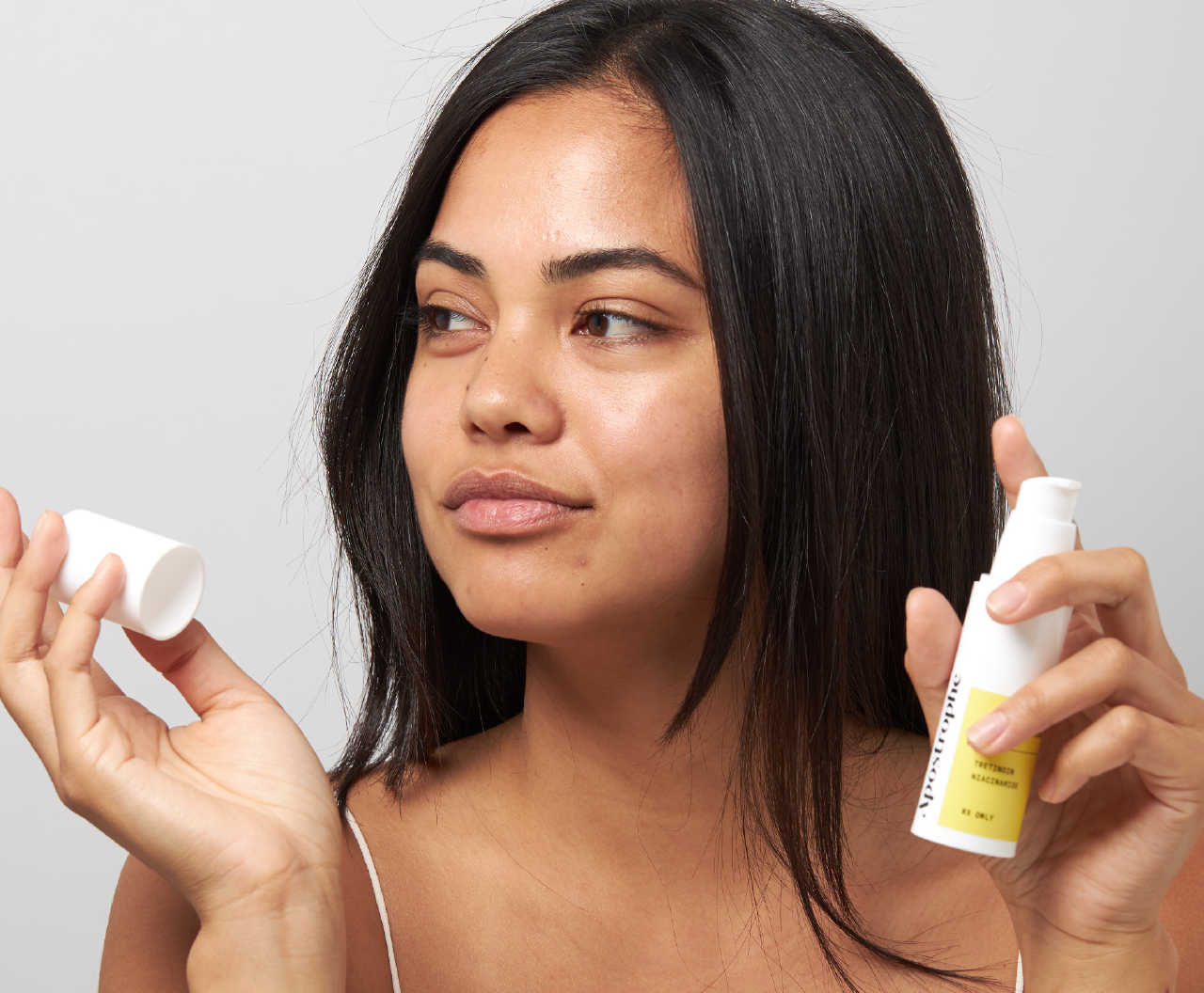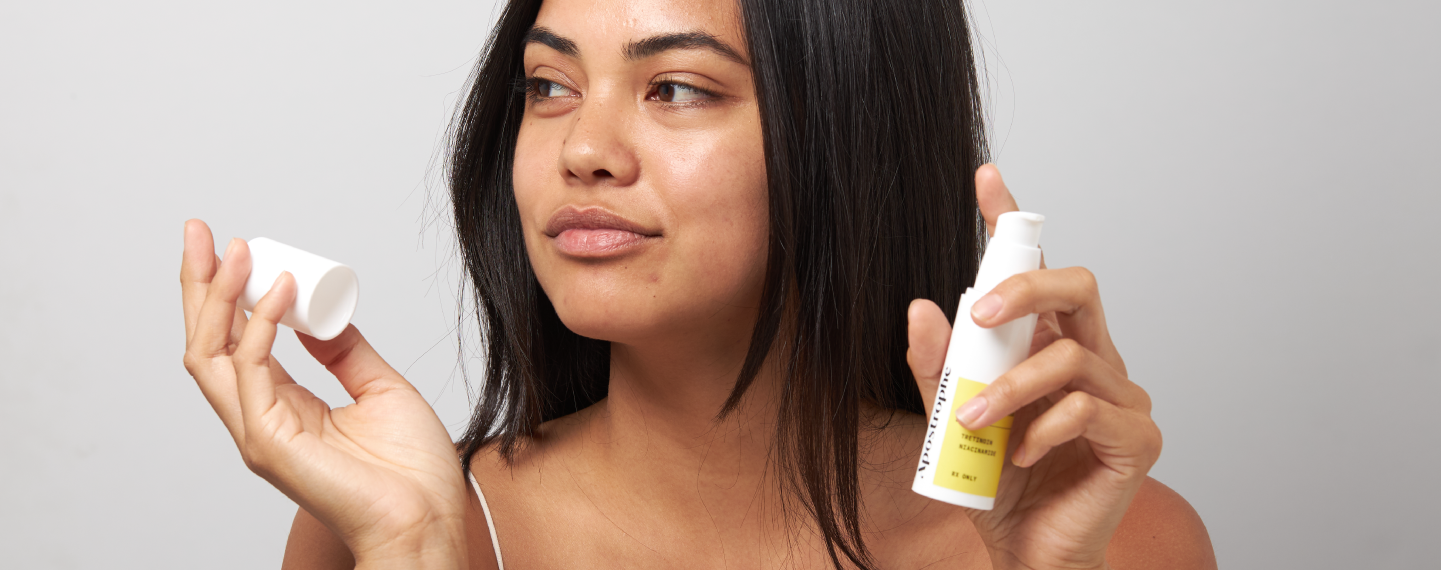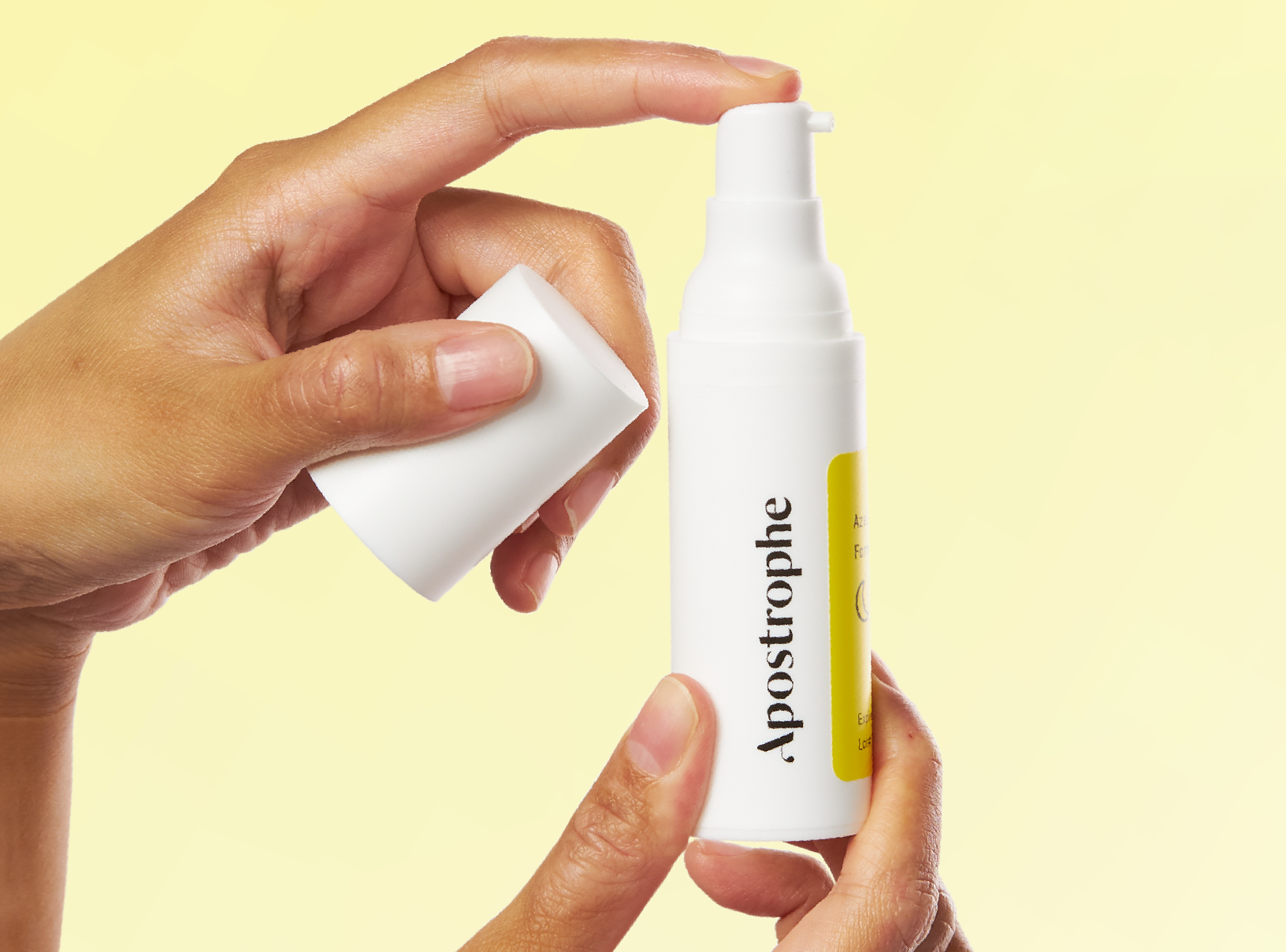Deep Dives
Adapalene (Differin) vs Tretinoin: Which is More Effective?


SHARE
Deep Dives
Adapalene (Differin) vs Tretinoin: Which is More Effective?
Medically reviewed by Aimee Paik, MD
Written by Apostrophe Team
Last updated 11/3/2024
When it comes to dealing with acne, retinoids — a class of medications derived from vitamin A — are some of the most effective tools available.
Tretinoin and adapalene are two of the most popular, widely used retinoids on the market. One (tretinoin) is a prescription-only medication with a usage history covering over half a century.
The other (Adapalene) is a newer, third-generation retinoid that’s available both as prescription medication and, as of 2016, as an over-the-counter treatment.
Because tretinoin and adapalene both belong to the same class of medications and offer similar benefits, choosing the right retinoid for your needs isn’t always an easy process. On paper, both drugs can look almost exactly the same, with similar benefits and potential side effects.
Below, we’ve compared tretinoin and adapalene as acne and anti-aging treatments, looking at everything from the scientific study data for each treatment to their potential side effects, safety, cost and other factors.
Tretinoin
Used through the 1960s to treat a variety of skin disorders, tretinoin was first discovered as a potential treatment for acne in 1969, and in 1971 became the first retinoid approved by the FDA to help treat acne vulgaris.
In the United States, it’s sold as a prescription medicine, meaning you’ll need to speak to a healthcare professional before you can buy it from a pharmacy.
As an acne and anti-aging treatment, tretinoin is typically sold as a topical cream or gel. Tretinoin can take several months before delivering noticeable results, so it’s important to understand it’s a process that takes time.
Topical tretinoin comes in several different strengths, ranging from .01 percent to .1 percent tretinoin. Most tretinoin users start by using a cream or gel with a low to moderate concentration and adjust their tretinoin dosage based on their results and side effects.
Tretinoin is a well-researched drug, with comprehensive studies covering everything from its effectiveness as an acne and anti-aging treatment to its potential side effects, long-term benefits and mechanism of action.
Our Tretinoin 101 guide, linked below, lists many of these studies, with plenty of data on how and why tretinoin works as an acne and anti-aging medication.
On the whole, tretinoin is a safe and effective drug. Its common side effects include redness of the skin to an increase in sensitivity to sunlight. Tretinoin also has a variety of uncommon side effects that range from skin discoloration to inflammation and even blisters.
If you’ve started taking tretinoin and experience any of these side effects, it’s best to speak with your healthcare provider immediately.
And while the side effects of tretinoin can be annoying, the good news is that they typically subside within one to two weeks when managed properly, as your body becomes acclimated to the medication.
As with most retinoids, tretinoin can trigger what’s called the tretinoin “purge” — a short period in which acne gets worse before it gets better. This usually lasts for the first few weeks of use, and can be treated using moisturizer, sunscreen and other skincare products.
Overall, tretinoin has become something of an “industry standard” retinoid for good reason — it’s affordable, effective and safe. It works quickly and well, with studies showing reductions in acne lesions, wrinkles and hyperpigmentation (dark spots) for some people in as few as three months of use.
Beyond the “purge” and mild side effects, the major disadvantages of tretinoin are its effects on your skin’s sensitivity to sunlight.
When using tretinoin it is recommended that you avoid excessive sunlight and always use a sunscreen with a minimum SPF 15+. You will also need to use tretinoin daily for several months to see results. Sun sensitivity reverts back to normal after six months of use.
Another major disadvantage of tretinoin is that, from a chemical perspective, it’s quite a fragile substance. Tretinoin creams and gels can degrade quickly in sunlight.
Because of this fragility, it is recommended that you apply tretinoin cream at bedtime and do not use it at the same time as benzoyl peroxide.
All in all, tretinoin is an effective, safe medication that produces good results with the potential for few minor common side effects for users.
Adapalene
Approved by the FDA in 1996, adapalene is a relatively new, third-generation retinoid that’s sold as both a prescription medicine and in a lower concentration as an over-the-counter gel for acne prevention and treatment.
Like tretinoin, adapalene is a retinoid. However, it has several characteristics that make it quite a unique medication when compared to tretinoin.
First, adapalene can inhibit keratinocyte differentiation, making it helpful for decreasing microcomedone formations, treating inflammation and exfoliating mature comedones.
Second, adapalene has a more stable chemical structure than tretinoin, making it okay to use alongside other acne medications such as benzoyl peroxide.
Studies show that adapalene is effective at treating acne. In one study, between 69 percent and 74 percent of patients given adapalene experienced “dramatic reductions” in inflammatory and non-inflammatory acne lesions. Adapalene offers comparable efficacy to tretinoin, but appears to be less likely to cause irritation, according to some studies.
Adapalene is available in several different strengths. In the United States, it’s usually sold under the brand name Differin® and comes in four different forms: lotion (0.1 percent), cream (0.1 percent), solution (0.1 percent) and gel (0.3 percent).
Currently, the stronger .03 percent gel is only available with a prescription.
Unlike tretinoin, which is exclusively a prescription medicine, the lower-strength 0.1 percent forms of topical adapalene are available as over-the-counter drugs in most pharmacies in the United States.
As with tretinoin and other topical retinoids, adapalene has several potential side effects. The most common is an increase in skin sensitivity and dryness, particularly during the first few weeks of treatment.
During this period, your skin can feel more sensitive than normal. Many adapalene users notice a mild stinging or burning to the skin during this period. This usually resolves itself after a few weeks of consistent use, not unlike the tretinoin “purge” period.
Adapalene can also produce itching and redness — potential side effects that it shares with other topical retinoids.
Like tretinoin, side effects from adapalene are fairly uncommon and usually occur in the first few weeks of treatment.
Which Medication Is More Effective?
Tretinoin and adapalene are both highly effective at treating acne. Studies show that both drugs produce a significant reduction in acne lesions over the long term.
In the study linked above, both medications showed an effective total decrease in acne lesions of 69 percent to 74 percent over the course of eight weeks.
If you have mild or moderate acne, both tretinoin and adapalene are likely to produce a lasting, significant improvement if used consistently.
On the whole, studies comparing tretinoin and adapalene typically find that tretinoin is slightly more effective as an acne treatment. In a review of tretinoin and adapalene, researchers found that tretinoin .05 percent gel “exhibits a greater anti-acne efficacy” than adapalene 0.1 percent gel.
This means that if you have severe or persistent acne, you may get better results from tretinoin than by using a .1 percent, over-the-counter form of adapalene. However, it’s best to discuss your options with your healthcare provider to figure out what’s best for you.
Studies of the two drugs also show that tretinoin typically produces slightly higher levels of skin irritation than adapalene. In the same review linked above, researchers found that tretinoin has a “higher skin irritation potential” when used as a long-term acne prevention treatment.
Because of this, if you have sensitive skin that gets irritated, itchy or uncomfortable easily, you may be better suited for the less irritating nature of adapalene over tretinoin.
Long term, both drugs are effective and safe. A 52-week study of adapalene 0.3 percent gel (the higher, prescription-only concentration of topical adapalene) found that only 21 percent of users experienced side effects from the treatment, of which the most common were dry skin, scaling and skin discomfort.
The researchers concluded that adapalene 0.3 percent gel was “safe and effective in the long-term” [sic.] as an acne treatment.
Long-term studies of tretinoin show similar results, with a low rate of side effects, most of which occur during the first few weeks of treatment and improve over time.
In fact, one study even notes specifically that, “the most noteworthy, but unexpected observation” made by researchers was how quickly the skin of the participants acclimated to tretinoin’s side effects, which occurred in the first two weeks of treatment.
While tretinoin and adapalene have numerous similarities when it comes to treating acne, the two drugs are very different as anti-aging treatments.
Despite both drugs being retinoids, only tretinoin has an established record of working as an anti-aging treatment, with countless studies showing a reduction in wrinkles, skin discoloration and other signs of photoaging over the long term.
Adapalene, on the other hand, is not as well-studied as an anti-aging treatment and is usually not prescribed frequently as tretinoin to treat the signs of aging. Because of this, it may not be recommended first if your goal is to reduce the visibility of wrinkles, creases or pigmented spots.
Which Cream Should You Choose?
Tretinoin and adapalene both offer a range of benefits. Tretinoin is a proven, well established drug that’s been in use for decades. It’s scientifically proven to reduce acne, fight the signs of aging and improve a variety of factors related to skin health.
Adapalene is a newer drug that’s slightly less effective at treating acne than tretinoin. It’s sold over the counter and by prescription and tends to be slightly less irritating to the skin than tretinoin, making it worth considering if you have sensitive, easily-irritated facial skin.
Overall, both tretinoin and adapalene work well to remove and prevent acne. Both drugs take a few weeks to several months to start showing benefits, and both can cause a temporary “purge” period in which your skin looks worse before it looks better.
From an anti-aging perspective, tretinoin is the better choice for most people, with a great track record of reducing wrinkles, hyperpigmentation and other signs of skin aging.
For most people, the best choice is to talk to your healthcare provider about the two medications and work together to choose the best option for your specific needs. This approach can help you get the best results while limiting your risk of experiencing side effects from topical skin medication.
Learn More About Tretinoin
Are you interested in using tretinoin to prevent acne and reverse the signs of aging? Our guides to using tretinoin for acne prevention and for anti-aging cover the two most popular uses of this topical retinoid.
You can also learn more about tretinoin in our Tretinoin 101 guide, which covers everything from the development of tretinoin to its potential side effects, common brand names and more.
This article is for informational purposes only and does not constitute medical advice. The information contained herein is not a substitute for and should never be relied upon for professional medical advice. Always talk to your doctor about the risks and benefits of any treatment.
Shop this post

Tretinoin
Like what you just read? Sign up for our email list to get the scoop on skincare science delivered straight to your inbox.

Deep Dives
A dermatologist shares his thoughts on the recent studies about benzoyl peroxide and benzene.
Read More
Education
What is milia?
What is milia? Today, we’re jumping into one type of bump that you may have heard about most commonly in infants — milia.
Read More
Education
Best moisturizer for acne-prone skin
If you have combination acne-prone skin, figuring out which moisturizer is best for your skin might be tough. In this guide, we break down the best moisturizer for combination, acne-prone skin.
Read More
